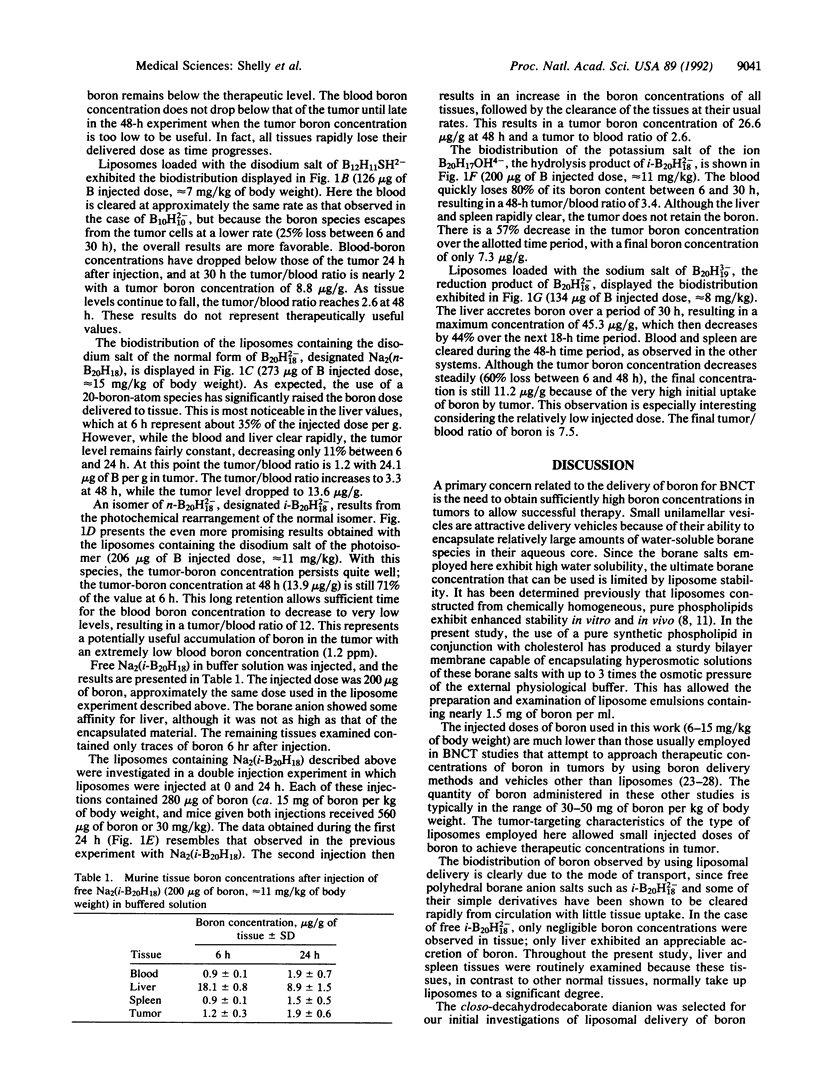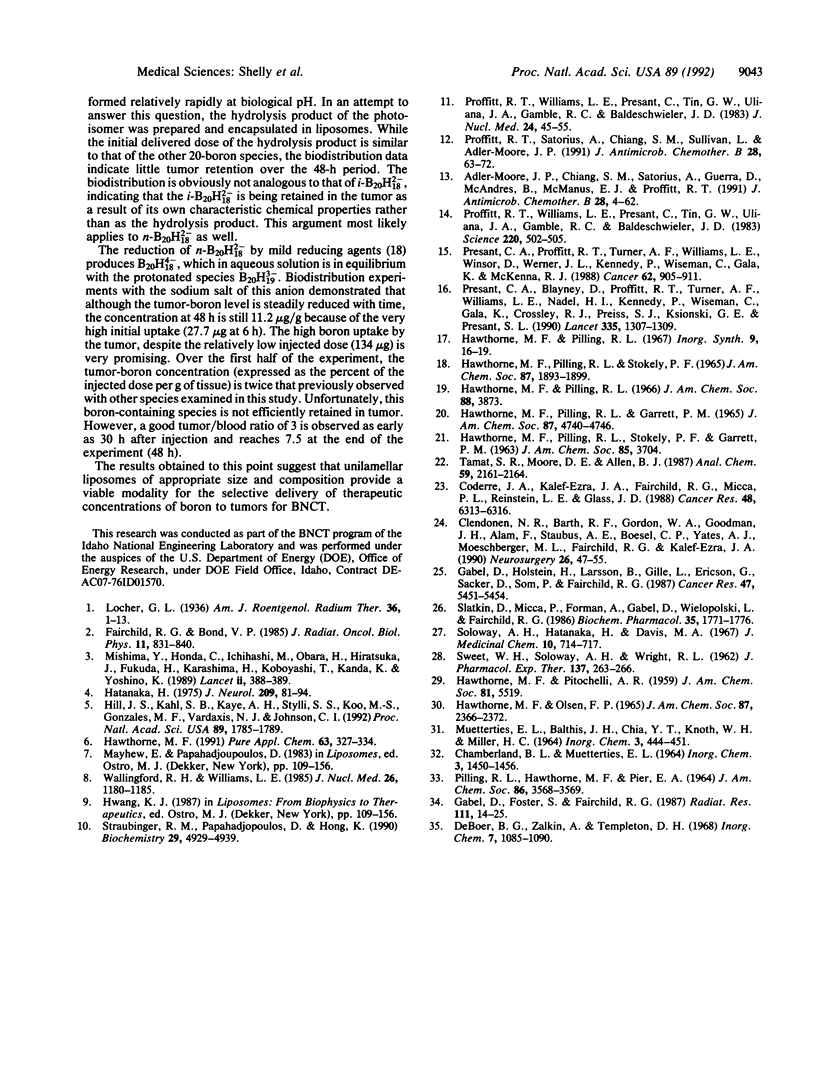Abstract
The successful treatment of cancer by boron neutron-capture therapy (BNCT) requires the selective concentration of boron-10 within malignant tumors. The potential of liposomes to deliver boron-rich compounds to tumors has been assessed by the examination of the biodistribution of boron delivered by liposomes in tumor-bearing mice. Small unilamellar vesicles with mean diameters of 70 nm or less, composed of a pure synthetic phospholipid (distearoyl phosphatidylcholine) and cholesterol, have been found to stably encapsulate high concentrations of water-soluble ionic boron compounds. The hydrolytically stable borane anions B10H10(2-), B12H11SH2-, B20H17OH4-, B20H19(3-), and the normal form and photoisomer of B20H18(2-) were encapsulated in liposomes as their soluble sodium salts. The tissue concentration of boron in tumor-bearing mice was measured at several time points over 48 h after i.v. injection of emulsions of liposomes containing the borane anions. Although the boron compounds used do not exhibit an affinity for tumors and are normally rapidly cleared from the body, liposomes were observed to selectively deliver the borane anions to tumors. The highest tumor concentrations achieved reached the therapeutic range (greater than 15 micrograms of boron per g of tumor) while maintaining high tumor-boron/blood-boron ratios (greater than 3). The most favorable results were obtained with the two isomers of B20H18(2-). These boron compounds have the capability to react with intracellular components after they have been deposited within tumor cells by the liposome, thereby preventing the borane ion from being released into blood.
Full text
PDF




Selected References
These references are in PubMed. This may not be the complete list of references from this article.
- Clendenon N. R., Barth R. F., Gordon W. A., Goodman J. H., Alam F., Staubus A. E., Boesel C. P., Yates A. J., Moeschberger M. L., Fairchild R. G. Boron neutron capture therapy of a rat glioma. Neurosurgery. 1990 Jan;26(1):47–55. doi: 10.1097/00006123-199001000-00007. [DOI] [PubMed] [Google Scholar]
- Coderre J. A., Kalef-Ezra J. A., Fairchild R. G., Micca P. L., Reinstein L. E., Glass J. D. Boron neutron capture therapy of a murine melanoma. Cancer Res. 1988 Nov 15;48(22):6313–6316. [PubMed] [Google Scholar]
- Fairchild R. G., Bond V. P. Current status of 10B-neutron capture therapy: enhancement of tumor dose via beam filtration and dose rate, and the effects of these parameters on minimum boron content: a theoretical evaluation. Int J Radiat Oncol Biol Phys. 1985 Apr;11(4):831–840. doi: 10.1016/0360-3016(85)90318-9. [DOI] [PubMed] [Google Scholar]
- Gabel D., Foster S., Fairchild R. G. The Monte Carlo simulation of the biological effect of the 10B(n, alpha)7Li reaction in cells and tissue and its implication for boron neutron capture therapy. Radiat Res. 1987 Jul;111(1):14–25. [PubMed] [Google Scholar]
- Gabel D., Holstein H., Larsson B., Gille L., Ericson G., Sacker D., Som P., Fairchild R. G. Quantitative neutron capture radiography for studying the biodistribution of tumor-seeking boron-containing compounds. Cancer Res. 1987 Oct 15;47(20):5451–5454. [PubMed] [Google Scholar]
- Hatanaka H. A revised boron-neutron capture therapy for malignant brain tumors. II. Interim clinical result with the patients excluding previous treatments. J Neurol. 1975 Jun 9;209(2):81–94. doi: 10.1007/BF00314601. [DOI] [PubMed] [Google Scholar]
- Hawthorne M. F., Berry T. E., Wegner P. A. The electronic properties of the 1,2- and 1,7-dicarbaclovododecaborane(12) groups bonded at carbon. J Am Chem Soc. 1965 Nov 5;87(21):4746–4750. doi: 10.1021/ja00949a014. [DOI] [PubMed] [Google Scholar]
- Hill J. S., Kahl S. B., Kaye A. H., Stylli S. S., Koo M. S., Gonzales M. F., Vardaxis N. J., Johnson C. I. Selective tumor uptake of a boronated porphyrin in an animal model of cerebral glioma. Proc Natl Acad Sci U S A. 1992 Mar 1;89(5):1785–1789. doi: 10.1073/pnas.89.5.1785. [DOI] [PMC free article] [PubMed] [Google Scholar]
- Mishima Y., Honda C., Ichihashi M., Obara H., Hiratsuka J., Fukuda H., Karashima H., Kobayashi T., Kanda K., Yoshino K. Treatment of malignant melanoma by single thermal neutron capture therapy with melanoma-seeking 10B-compound. Lancet. 1989 Aug 12;2(8659):388–389. doi: 10.1016/s0140-6736(89)90567-9. [DOI] [PubMed] [Google Scholar]
- Presant C. A., Blayney D., Proffitt R. T., Turner A. F., Williams L. E., Nadel H. I., Kennedy P., Wiseman C., Gala K., Crossley R. J. Preliminary report: imaging of Kaposi sarcoma and lymphoma in AIDS with indium-111-labelled liposomes. Lancet. 1990 Jun 2;335(8701):1307–1309. doi: 10.1016/0140-6736(90)91188-g. [DOI] [PubMed] [Google Scholar]
- Presant C. A., Proffitt R. T., Turner A. F., Williams L. E., Winsor D., Werner J. L., Kennedy P., Wiseman C., Gala K., McKenna R. J. Successful imaging of human cancer with indium-111-labeled phospholipid vesicles. Cancer. 1988 Sep 1;62(5):905–911. doi: 10.1002/1097-0142(19880901)62:5<905::aid-cncr2820620509>3.0.co;2-3. [DOI] [PubMed] [Google Scholar]
- Proffitt R. T., Williams L. E., Presant C. A., Tin G. W., Uliana J. A., Gamble R. C., Baldeschwieler J. D. Liposomal blockade of the reticuloendothelial system: improved tumor imaging with small unilamellar vesicles. Science. 1983 Apr 29;220(4596):502–505. doi: 10.1126/science.6836294. [DOI] [PubMed] [Google Scholar]
- Proffitt R. T., Williams L. E., Presant C. A., Tin G. W., Uliana J. A., Gamble R. C., Baldeschwieler J. D. Tumor-imaging potential of liposomes loaded with In-111-NTA: biodistribution in mice. J Nucl Med. 1983 Jan;24(1):45–51. [PubMed] [Google Scholar]
- Slatkin D., Micca P., Forman A., Gabel D., Wielopolski L., Fairchild R. Boron uptake in melanoma, cerebrum and blood from Na2B12H11SH and Na4B24H22S2 administered to mice. Biochem Pharmacol. 1986 May 15;35(10):1771–1776. doi: 10.1016/0006-2952(86)90342-4. [DOI] [PubMed] [Google Scholar]
- Soloway A. H., Hatanaka H., Davis M. A. Penetration of brain and brain tumor. VII. Tumor-binding sulfhydryl boron compounds. J Med Chem. 1967 Jul;10(4):714–717. doi: 10.1021/jm00316a042. [DOI] [PubMed] [Google Scholar]
- Straubinger R. M., Papahadjopoulos D., Hong K. L. Endocytosis and intracellular fate of liposomes using pyranine as a probe. Biochemistry. 1990 May 22;29(20):4929–4939. doi: 10.1021/bi00472a025. [DOI] [PubMed] [Google Scholar]
- Tamat S. R., Moore D. E., Allen B. J. Determination of boron in biological tissues by inductively coupled plasma atomic emission spectrometry. Anal Chem. 1987 Sep 1;59(17):2161–2164. doi: 10.1021/ac00144a033. [DOI] [PubMed] [Google Scholar]
- Wallingford R. H., Williams L. E. Is stability a key parameter in the accumulation of phospholipid vesicles in tumors? J Nucl Med. 1985 Oct;26(10):1180–1185. [PubMed] [Google Scholar]


